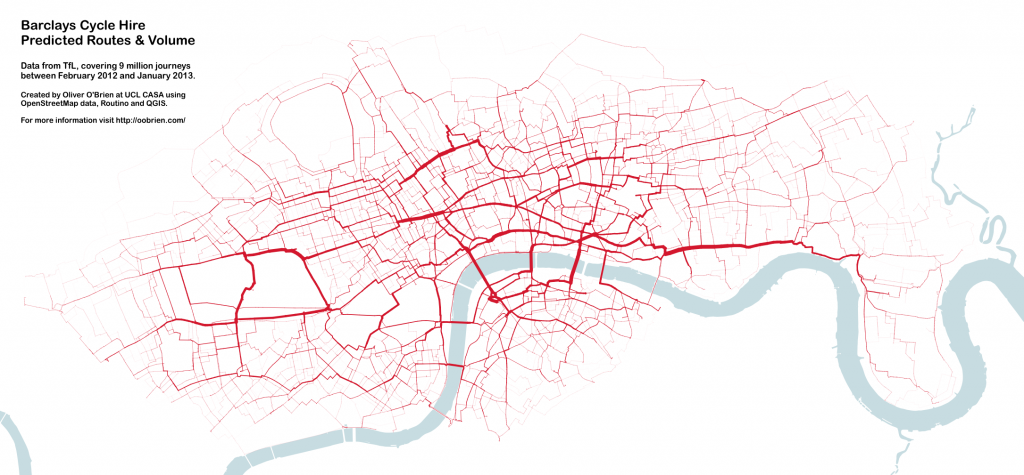
London Cycle Hire on the Cover of BMJ
 I produced this data map which forms the front cover of this week’s British Medical Journal (BMJ). The graphic shows the volumes of Barclays Cycle Hire bikeshare users in London, based on journeys from February 2012 to January 2013 inclusive. The routes are the most likely routes between each pair of stations, as calculated using Routino and OpenStreetMap data. The area concerned includes the February 2012 eastern extension to Tower Hamlets (including Canary Wharf) but not the December 2013 extension to Putney. The river was added in from Ordnance Survey’s Vector Map District, part of the Open Data release. QGIS was used to put together the calculated results and apply data-specified styling to the map.
I produced this data map which forms the front cover of this week’s British Medical Journal (BMJ). The graphic shows the volumes of Barclays Cycle Hire bikeshare users in London, based on journeys from February 2012 to January 2013 inclusive. The routes are the most likely routes between each pair of stations, as calculated using Routino and OpenStreetMap data. The area concerned includes the February 2012 eastern extension to Tower Hamlets (including Canary Wharf) but not the December 2013 extension to Putney. The river was added in from Ordnance Survey’s Vector Map District, part of the Open Data release. QGIS was used to put together the calculated results and apply data-specified styling to the map.
The thickness of each segment corresponds to the volume of cyclists taking that link on their journey – assuming they take the idealised calculated route, which is of course a not very accurate assumption. Nevertheless, certain routes stand out as expected – the Cycle Superhighway along Cable Street between the City and Canary Wharf is one, Waterloo Bridge is another, and the segregated cycle route south of Euston Road is also a popular route.
The graphic references an article in the journal issue which is on comparing health benefits and disbenefits of people using the system, with comparison to other forms of transport in central London. Pollution data is combined with accident records and models. The paper was written by experts at the UKCRC and the London School of Hygiene and Tropical Medicine (LSHTM) and I had only a very small part in the paper itself – a map produced by Dr Cheshire and myself was used to illustrate the varying levels of PM2.5 (small particulate matter) pollution in different parts of central London and how these combine with the volume of bikeshare users on the roads and cycle tracks. The journal editors asked for a selection of images relating to cycle hire in London in general and picked this one, as the wiggly nature and predominant red colour looks slightly like a blood capillary network.
A larger version of the graphic, covering the whole extent of the bikeshare system at the time, is here or by clicking on this thumbnail of it:
Very rare journeys, such as those from London Bridge to Island Gardens, have faded out to such an extent that they are not visible on the map here. An example route, which the map doesn’t show due to this, goes through Deptford and then through the Greenwich Foot Tunnel.
For an interactive version of the graphic (using a slightly older dataset) I recommend looking at Dimi Sztanko’s excellent visualisation.

